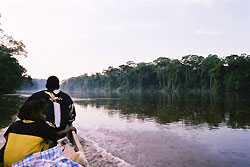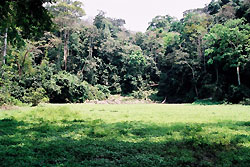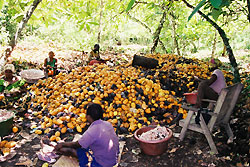(3) The field research was conducted from July 15, 2003 to March 31, 2004 in the villages of Mindourou, Leke and Ndongo, situated along the Dja river in the Boumba and Ngoko District of the East Province, Cameroon. While the climate of this area is classified as a "tropical rainforest," there are clear seasons throughout the year; there is a major dry season from the middle of December to February, a minor rainy season from March to June, a minor dry season in July and August, and a major rainy season from September to mid-December. The vegetation type is classified as semi-deciduous forest, composed of both evergreen and deciduous, shade-intolerant tree species.
The field research was devoted to examining the impacts of human activities on changes of vegetation in the secondary forest, including surveys on the following: (1) interviews and observations of present human subsistence activities and land use systems, (2) vegetation survey of primary and secondary forests (such as old village sites and abandoned fields), (3) interviews on historical changes in land use systems, (4) locating and mapping of old village and field sites with the aid of a GPS system, and (5) vegetation surveys at these sites.
The field research was devoted to examining the impacts of human activities on changes of vegetation in the secondary forest, including surveys on the following: (1) interviews and observations of present human subsistence activities and land use systems, (2) vegetation survey of primary and secondary forests (such as old village sites and abandoned fields), (3) interviews on historical changes in land use systems, (4) locating and mapping of old village and field sites with the aid of a GPS system, and (5) vegetation surveys at these sites.
The three villages are inhabited by people who call themselves "Djako." Their major subsistence activity is slash-and-burn agriculture. In addition, fishing on the Dja river, as well as gathering and hunting in the surrounding forest also comprise important daily subsistence activities. Furthermore, cacao bean cultivation has now become an important cash income activity. These villages are located along a recently reconstructed road, which terminates at Ndongo village (where the FS is located) on the Dja riverbank. The present village site is surrounded by secondary vegetation, such as cultivated fields and fallows dominated by Musanga cecropioides. The primary forest extends into the area beyond the secondary vegetation. In the primary forest, trees such as Triplochiton scleroxylon (Steruculiaceae) and Entandrophragma cylindricum (Meliaceae) were commonly observed, but none were seen as dominating the forest vegetation. On the other hand, in the forest under-story, shrubs such as Meiocarpidium lepidotum (Annonaceae) and Sloetiopsis usambarensis (Moraceae) comprised the dominant species.
According to the villagers, "Djako" means "the upper reaches of the Dja river, or the people who live there." They said they had moved their villages along the Dja from an area about 30km upstream. During my research, twenty old village sites (of which the oldest was abandoned more than a century ago) were located using GPS. In the area about 20 km further upstream, various types of vegetation were found, including, for example, stands of raphia palms, (important materials for construction and furniture), pure stands of Gilbertiodendron dewevrei (the bark is used for medicine as well as for other purposes), swampy grassland frequented by elephants and other large mammals, and shallow water used for seasonal fishing grounds. Thus, the Dja area is comprised of various types of environment at different stages of vegetation change and with different ecological characteristics. People recognize these differences and use the areas accordingly, depending on their purposes.
Further research on the vegetation will be conducted in several old village sites along the Dja, and information about the ecological history of the area will be gathered in order to grasp the historical relationship between human activities and forest environments. Following this, changes in the macro-system (the socio-economic conditions of society at large promoting, for example, the introduction of cacao cultivation into the area, expansion of logging operations, construction of road networks, and implementation of nature conservation projects) will be investigated, and the impacts of these changes on subsistence activities and forest use will be demonstrated. Finally, the implications of these results will be examined in terms of the goal of making sustainable use of the forest resources.



 21st Century COE Program
-Aiming for COE of Integrated Area Studies-
21st Century COE Program
-Aiming for COE of Integrated Area Studies-